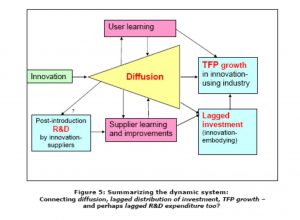Yesterday brought the launch of a new and revised edition of Doing Capitalism in the Innovation Economy by William Janeway. Anybody who read the first (2012) edition will recall the theme of the ‘three player game’ – market innovators, speculators and the state – informed by Keynes and Minsky as well as Janeway’s own experience combining an economics PhD with his experience shaping the world of venture capital investment.
The term refers to how the complicated interactions between government, providers of finance and capitalists drive technological innovation and economic growth. The overlapping institutions create an inherently fragile system, the book argues – and also a contingent one. Things can easily turn out differently.
The book starts with a more descriptive first half, including Janeway’s “Cash and Control” approach to investing in new technologies, and also an account of how the three players in the US shaped the computer revolution. This is an admirably clear but nuanced history emphasising the important role of the state – through defense spending in particular – but also the equally vital private sector involvement. I find this sense of the complicated and path dependent interplay far more persuasive than simplistic accounts emphasising either the government or the market.
The second half of the book takes an analytical turn, covering financial instability, and the role of state action. It’s fair to say Janeway is not a fan of much of mainstream economic theory (at least macro and financial economics). He includes a good deal of economic history, and Carlota Perez features alongside Minsky in this account.
The years between the two editions of the book, characterised by sluggish growth, flatlining productivity, and also extraordinary changes in the economy and society brought about by technology perhaps underline the reasons for this lack of esteem. After all, there do seem to be some intractable ‘puzzles’, and meanwhile, just in time for publication, Italy looks like it might be kciking off the Euro/banking crisis again. The experience of the past few years also helps explain the rationale for a second edition. That’s quite a lot of economic history and structural change packed into half a decade.
Although I read the first edition, I’m enjoying the second as well. And for those who didn’t read the book first time around, there’s a treat in store.
[amazon_link asins=’1108471277′ template=’ProductAd’ store=’enlighteconom-21′ marketplace=’UK’ link_id=’39f773b9-63ec-11e8-af2f-ffd876094224′]


 This was exactly the argument made yesterday at a Bank of England seminar I attended by Hal Varian (now chief economist at Google, known to all economics students as author of
This was exactly the argument made yesterday at a Bank of England seminar I attended by Hal Varian (now chief economist at Google, known to all economics students as author of